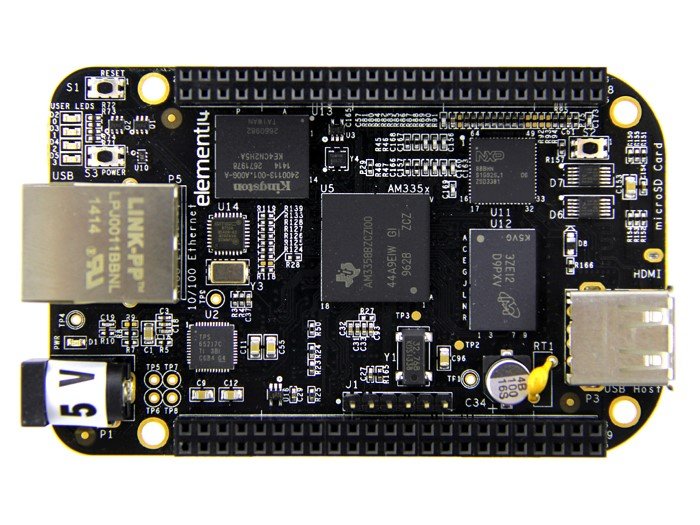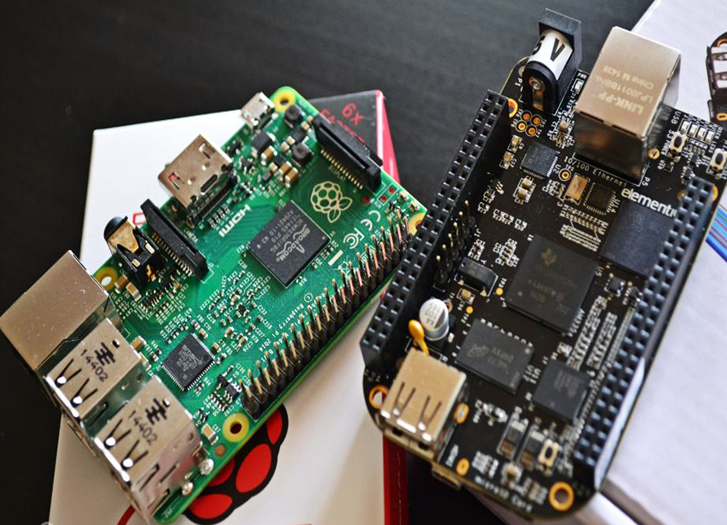BEAGLEBONE
Beaglebone is a single board computer (SBC) which was developed by Texas Instruments in 2013. Beaglebone is designed with open source software and it consumes low power. Beagle bone is designed with all basic functionality of the computer.

Specification:
Beagle bone provides 92 expansion pins with 46 pins female connector. It has 5 serial pins for debugging. GPIO Real-time units. Real-time Coprocessor provides system control and fast communication. Beaglebone provides 4GB onboard storage and it has an SD card. Beaglebone can also accept analog inputs. The 92 expansion pins include certain interfaces. BeagleBoard measures 75 by 75 mm and this function as a computer.
Interfaces in Beaglebone:
- It has 3 I2c buses for serial communication
- CAN bus
- Spi bus
- It has 4 timers
- It has 65 GPIO pins
- It has seven analog inputs (1.8v max 12 bit A/D converters)
BEAGLEBONE FAMILY:
Beaglebone is introduced in certain types with small modification with the previous board

- BeagleBoard rev. C :
It has a package on package (PoP) SoC/Memory chip. This uses the Processor TI OMAP 3530 SoC – 720 MHz with ARM CORTEX-A8 core. Imagination Technologies with 2D/3D graphics processor supporting displays. Beaglebone is designed with256 MB LPDDR RAM and 256 MB NAND Flash memory. Beaglebone provides with HDMI connector with the maximum resolution of 1280×1024 and has USB OTG (mini-AB) with1 USB port. It has SD/MMC card slot and Stereo in and out jacks. This Beaglebone has JTAG connector and power socket 5v of barrel connector type. Boot from NAND memory, SD/MMC and USB. It has an alternate boot source button.
- BeagleBoard-xM :
BeagleBoard-xM is another model of beagle bone released in 2010. It is bigger than the Beaglebone rev.c and it measures about 82.55 by 82.55 mm. It also has a faster CPU core clocked at 1 GHz compared to the 720 MHz of the BeagleBoard and more RAM (512 MB compared to 256 MB). This Beaglebone is provided with onboard Ethernet jack and with 4 USB ports. The BeagleBoard-xM lacks the onboard NAND and therefore requires the OS and other data are stored on microSD card. In addition to the Camera port to the -xM provides a simple way of importing video. This is designed with inbuilt memory with 512 MB LPDDR RAM with 4 GB microSD card supplied with the BeagleBoard-xM. BeagleBoard-xM having an HDMI connector with the maximum resolution of 1400×1050.this also having 4 USB ports, and Ethernet for accessing the internet. MicroSD/MMC card is also used for storing the data. For audio, it has Stereo in and out jacks. For powering the device it has Power socket (5 V barrel connector type). BeagleBoard-xM is provided with the separate camera port.
- Beaglebone Black:
Beaglebone black is a single board computer.it is most commonly used. For storage, it uses 512MB DDR3 RAM and 4GB 8-bit eMMC onboard flash storage. It has 3D graphics accelerator for better performance of CPU.NEON floating-point accelerator. Beaglebone black has 2x PRU 32-bit microcontrollers. It has 3 I2c buses for serial communication. CAN and Spi bus for communication. It has 4 timers and 65 GPIO pins. Beaglebone black has seven analog inputs used 1.8v max 12 bit A/D converters.
- BeagleBone Blue:
BeagleBoneBlue is an all-in-one Linux-based computer for robotics, integrating onto a single small (3.5″ x 2.15″) board the Octavo OSD3358 microprocessor. It has both wifi and Bluetooth for connectivity, IMU/barometer, power regulation and state-of-charge LEDs for a 2-cell LiPo, H-Bridges, and discrete connectors for 4 DC motors and encoders.it also having 8 servos, and it has all of the commonly-needed buses for additional peripherals in embedded applications. Beaglebone blue is open source and actively supported by a strong community, the real-time performance, flexible networking, and rich set of robotics-oriented capabilities make building mobile robots with the Blue fast and streamlined.it has AM335x 1GHz ARM® Cortex-A8 processor and for internal storage memory its with 512MB DDR3 RAM and with 4GB 8-bit eMMC flash storage. It has integrated power management. Majorly 2×32-bit 200-MHz programmable real-time units (PRUs) and neon floating-point accelerator. Beaglebone uses ARM Cortex-M3 processor.for the purpose of power and communication it has USB2 client. This uses 2-cell LiPo with balancing, LED state-of-charge monitor as a battery. For Charging it needs input upto 9-18V.it having Wireless connectivity 802.11bgn, Bluetooth 4.1 and BLE. For Motor control of 8servos, it has eight 6V servo out, 4 bidirectional DC motor out, 4 quadrature encoder. It has 9 axis IMU sensors (accels, gyros, magneto meter), barometer, thermometer. Beaglebone has 11 user programmable LEDs, 2 user programmable buttons for the user interface. It also having additional buses and peripherals including GPS, DSM2 radio. For communication, it uses UART protocol, SPI protocol, I2C protocol, 1.8V analog, 3.3V GPIOs.Beaglebone can be worked in platforms like ROS, Ardupilot, MATLAB and Simulink, Labview, Cloud9 IDE on Node.js, python and opencv.
- BeagleBone Green:
BeagleBone Green (BBG) is a joint effort by BeagleBoard.org and Seeed Studio. It is based on the open-source hardware design of BeagleBone Black and developed into this differentiated version. The BBG has included two Grove connectors, making it easier to connect to the large family of Grove sensors. On-board HDMI is removed to make room for these Grove connectors. BeagleBone Green uses the AM335x 1GHz ARM® Cortex-A8 processor. For storage, it has 512MB DDR3 RAM and 4GB 8-bit eMMC on-board flash storage. It has a graphics board called3D graphics accelerator for having better performance of like CPU. It has
NEON floating-point accelerator to improve the multimedia user experience. It also has 2x PRU 32-bit microcontrollers.
- BeagleBoard-X15:
The BeagleBoard-X15 is based on the TI Sitara AM5728 processor with two ARM Cortex-A15. Its core running at 1.5 GHz, two ARM Cortex-M4 cores running at 212 MHz and two TI C66x DSP core running at 700 MHz. This processor provides USB 3.0 support and has a PowerVR Dual Core SGX544 GPU running at 532 MHz.
- Pocket Beagle:
Pocket beagle is launched in September 2017. Pocket Beagle offers identical computing performance to BeagleBone Black in a physical form factor that offers over 50% reduction in size and 75% reduction in weight. This model is cost effective than the above models. The miniaturization was made possible by using the Octavo Systems OSD3358-SM that shrinks all major subsystems of the BeagleBone Black into a single ceramic package attached using a ball grid array. This advantages of the miniaturization come at the cost of removal of all built-in connectors except for a single micro USB port, the removal of on-board eMMC flash storage, and a reduction of header pins from 92 down to 72 due to space constraints, meaning that most capes will either not work at all or need heavy modifications to work with Pocket Beagle. Pocket Beagle include embedded devices where size and weight considerations are most critical, such as quadcopter drones and other miniaturized robotics, along with handheld gaming applications.
Languages to code Beaglebone:
Can write our code in almost any language like C, C++, Python, Perl, Ruby, Java, or even a shell script.
Linux software: Much of the Linux software that’s already out there can be run on the BeagleBone
Software capability:
Beaglebone can be used in Debian platform, Android. Can run Ubuntu linux distribution on Beaglebone black and Cloud9 IDE on Node.js w/ BoneScript library can be used.
Raspberry pi vs Beaglebone:
| Raspberry pi has 26 pin header | Beaglebone has 92 pin header |
| 8 GPIO pin,1 UART,1 SPI bus,1 I2C bus and has no on board storage | 65 GPIO pin, 3 I2C, 1 CAN bus,1 SPI bus. Beaglebone has 4GB on board storage |
| Processor–Architecture of Raspberry pi uses ARMV6 GPU– Dual Core Video Core IV® Multimedia Co-Processor Memory– 512MB SDRAM | Processor–Architecture of Beaglebone uses ARMV7 GPU– Power VR SGX530 Memory– 512 MB DDR3
|
